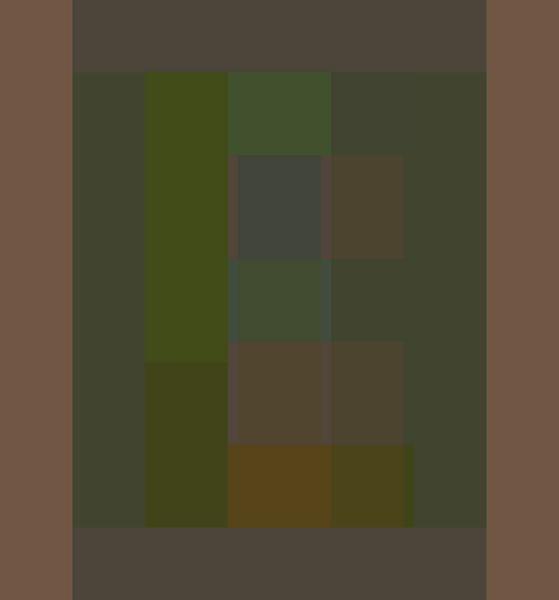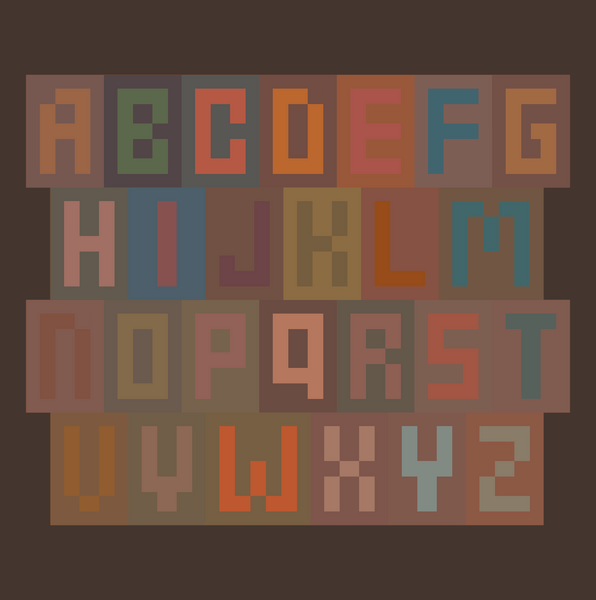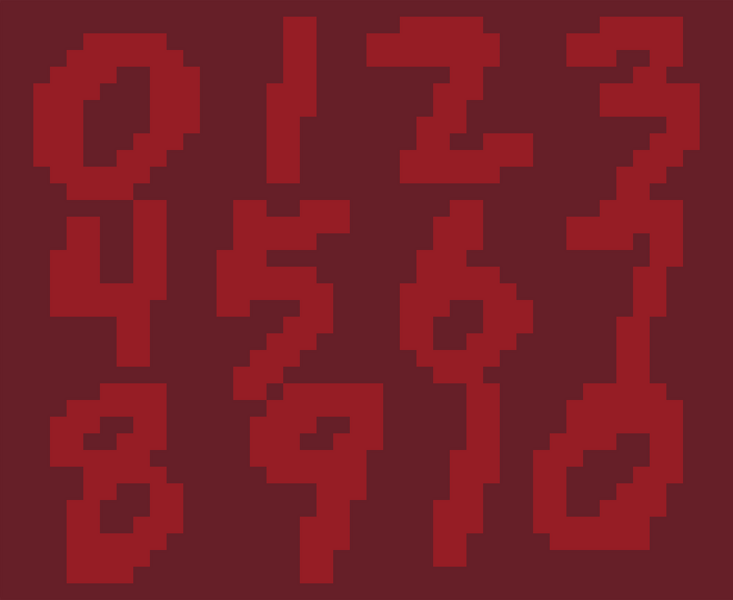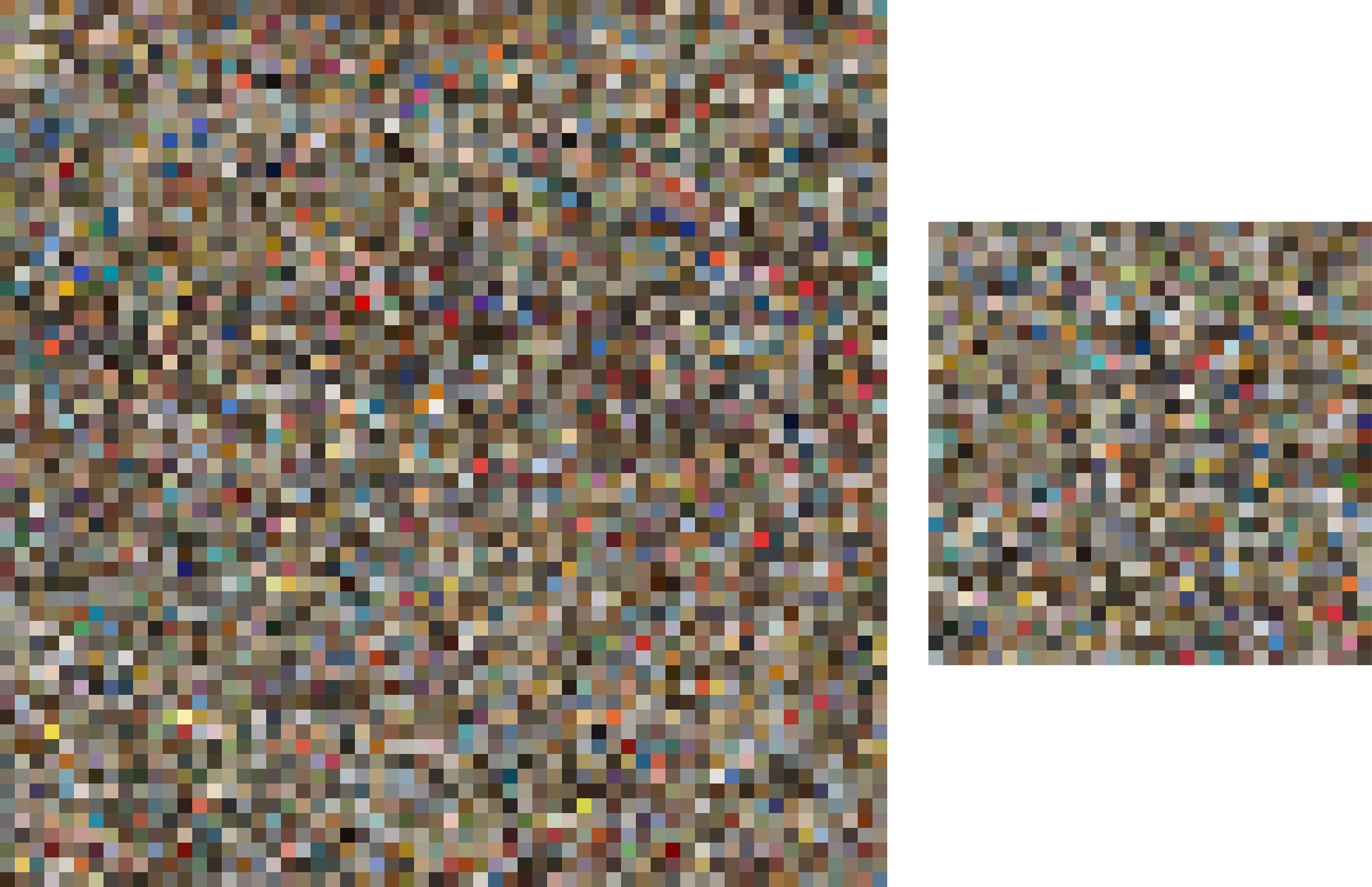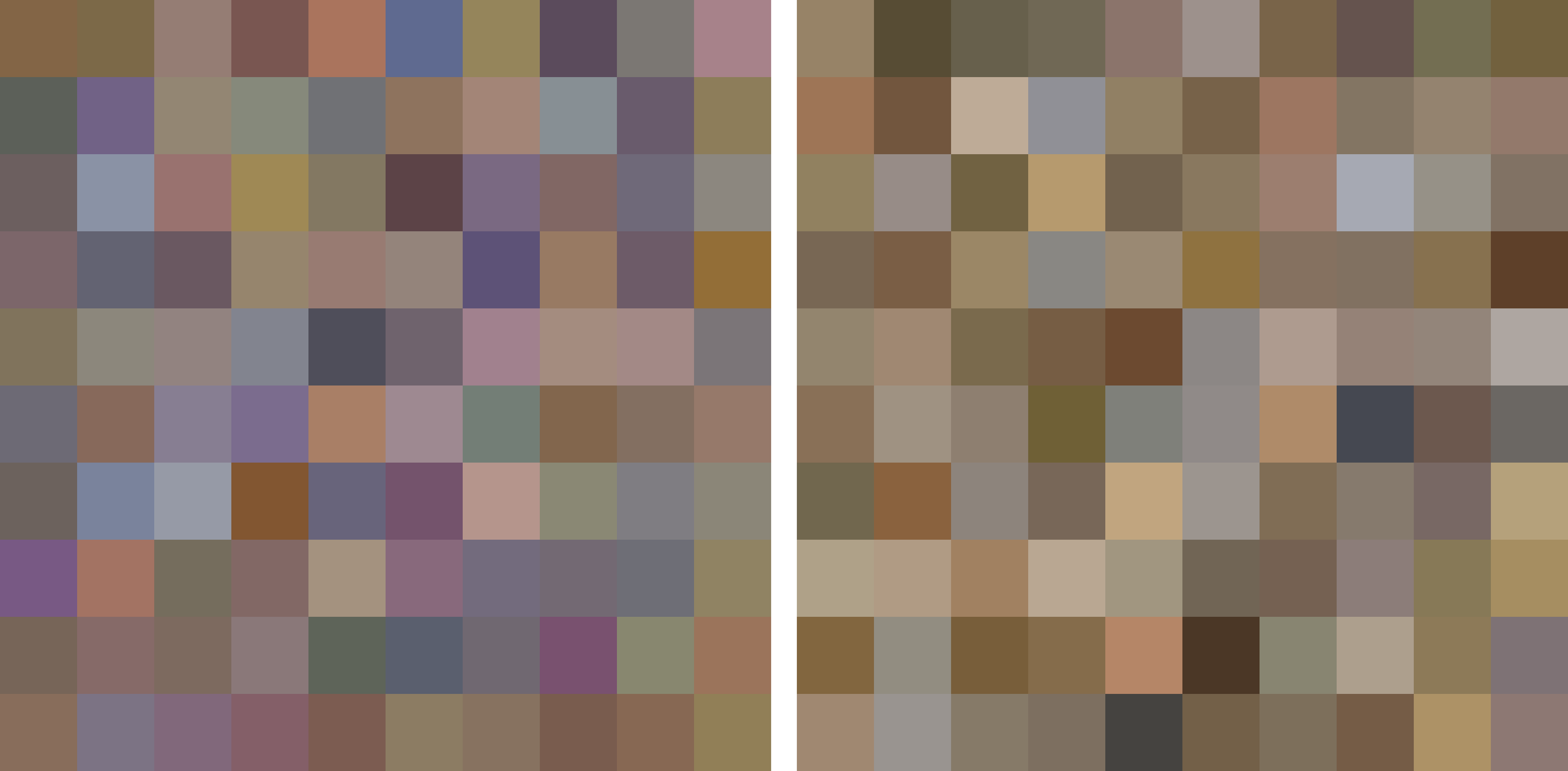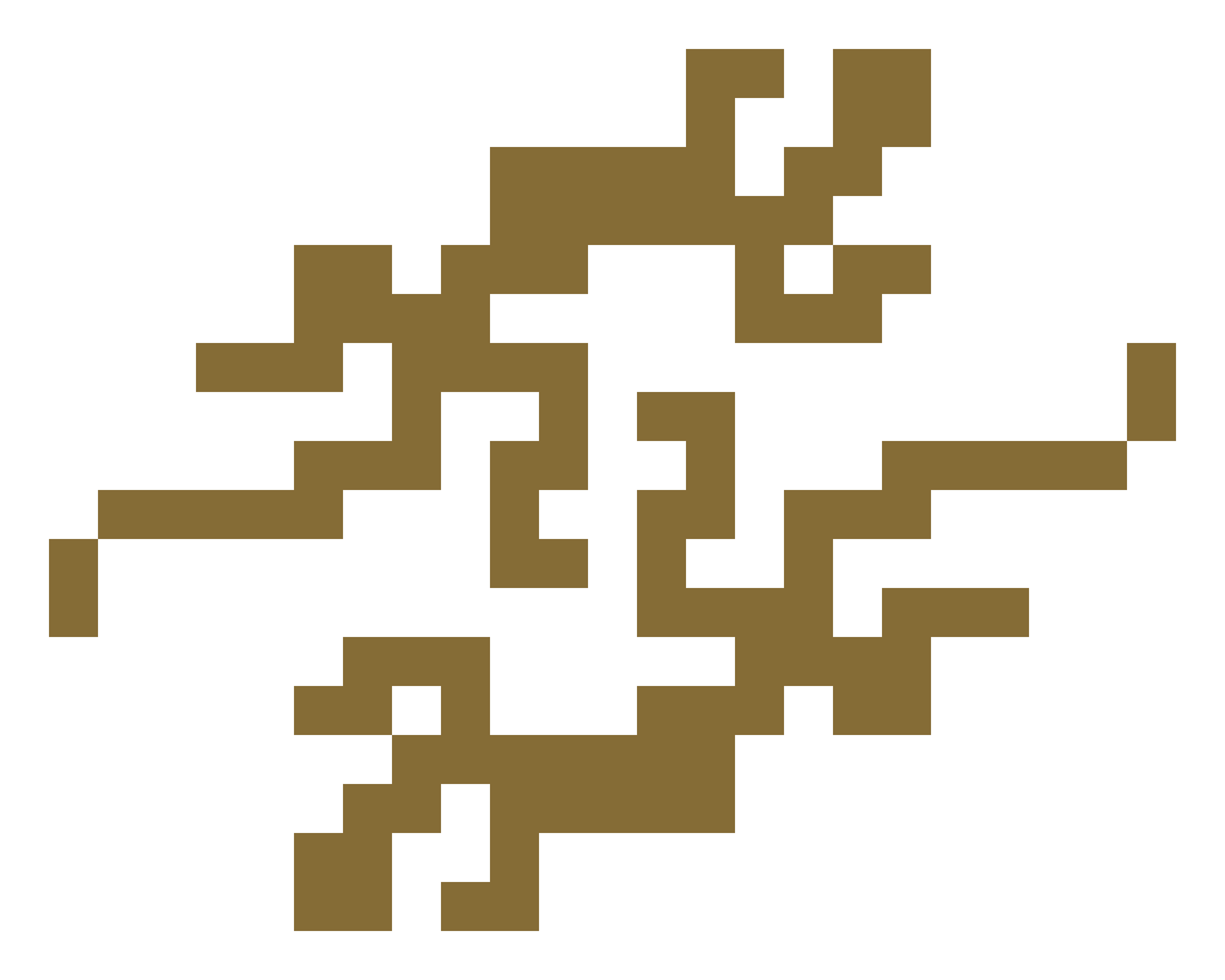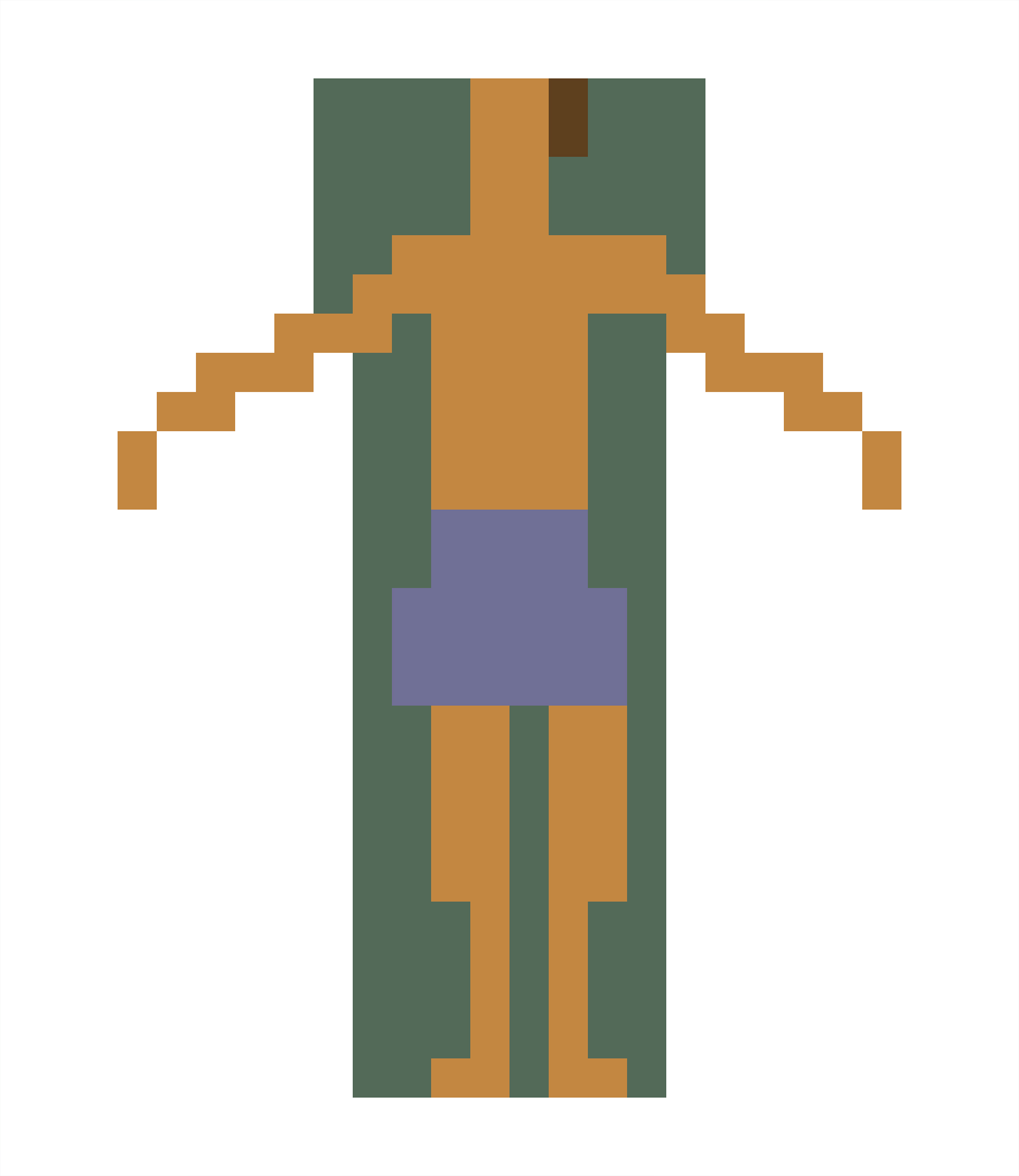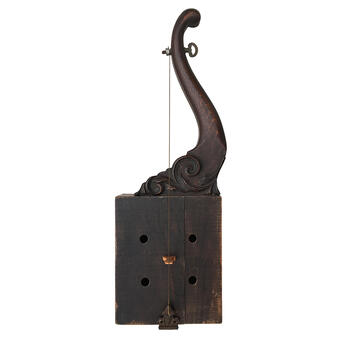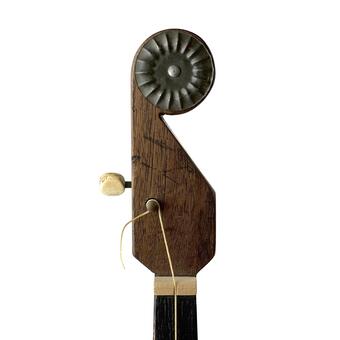Work samples
-
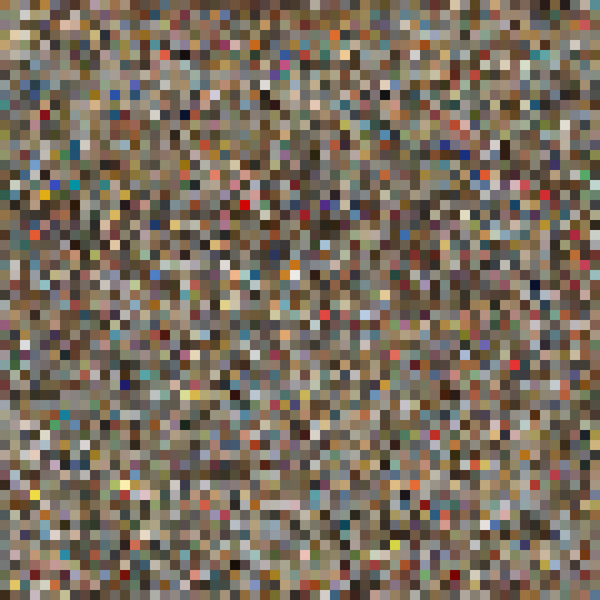 Volume AThis is the first work from my Art History Project, started in 2015. At first there appeared a simple curiosity. Is it possible to imagine all this mass of canvases as a single color composition? We have to apply a common denominator to each picture in the form of an average color, we will see a mosaic consisting of multi-colored pixels. But the task of processing billions of paintings seems overwhelming without some kind of sampling. The principle must be completely randomized. For the beginning, let's take artists whose last name starts with the letter A and select one painting of each artist (the first one in a Google search). Belonging to time, genre, art school and other color determining features will be completely excluded. The result is a 3600, or 60x60 pixel composition representing artists starting with the letter A.
Volume AThis is the first work from my Art History Project, started in 2015. At first there appeared a simple curiosity. Is it possible to imagine all this mass of canvases as a single color composition? We have to apply a common denominator to each picture in the form of an average color, we will see a mosaic consisting of multi-colored pixels. But the task of processing billions of paintings seems overwhelming without some kind of sampling. The principle must be completely randomized. For the beginning, let's take artists whose last name starts with the letter A and select one painting of each artist (the first one in a Google search). Belonging to time, genre, art school and other color determining features will be completely excluded. The result is a 3600, or 60x60 pixel composition representing artists starting with the letter A.
About Genna
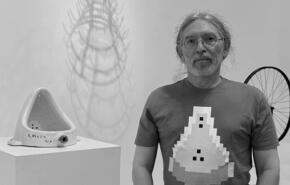
Genna Gurvich, a conceptual artist living in Baltimore, Maryland. He is a graduate of the Kiev (Ukraine) Institute of Applied Arts and Design and holds a master's degree in System Design from the St. Petersburg Academy of Arts and Industrial Design (Russia).
The primary interest in his practice, Genna Gurvich considers the interconnections and interdependencies in the history of art and culture as a whole. Utilizing computer algorithms, he creates a new visual panorama of these… more
Art History Project, 2015-2022
Imagine a special art history where each painting is represented by a single pixel, created by averaging the painting’s color palette. The uniqueness of each pixel lies in its almost unrepeatable color. In the digital world, the simplest color model contains 16.8 million color variations. This allows me to combine large arrays of pixels into compositions that reflect periods, collections, or art movements and compare their chromatic differences.I can pose both simple and complex questions that have not been asked before:
* Is there a difference between artists whose names start with the letter A and those with the letter Z?
* How do various art movements differ from one another?
* What are the unique features of museum collections?
* How do the color palettes in the paintings of men and women intersect?
* Are there noticeable differences between pre-war and post-war years?
* How does the color palette of an artist’s work change between youth and maturity?
* A comparison of official and unofficial art in the USSR and Nazi Germany.
* Is there a noticeable difference in the palettes of good and bad paintings (expensive and inexpensive)?
* Comparison of the color palettes of nations.
And so on…
-
 Volume A and Z
Volume A and ZFor the beginning, let's take artists whose last name starts with the letter A and select one painting of each artist (the first one in a Google search). Belonging to time, genre, art school and other color determining features will be completely excluded. The result is a 3600, or 60x60 pixel composition representing artists starting with the letter A. Now let's repeat the same with the letter Z. Here we have 900, or 30x30 pixels. But we see that the overall coloring remains unchanged. You can extrapolate the result and conclude that all other letters will give a similar flavor with a difference only in the number of pixels. Topic closed. Issue resolved. Is not it? 2015, 60x60 and 30x30 inches, archival pigment print on Exhibition fiber.
-
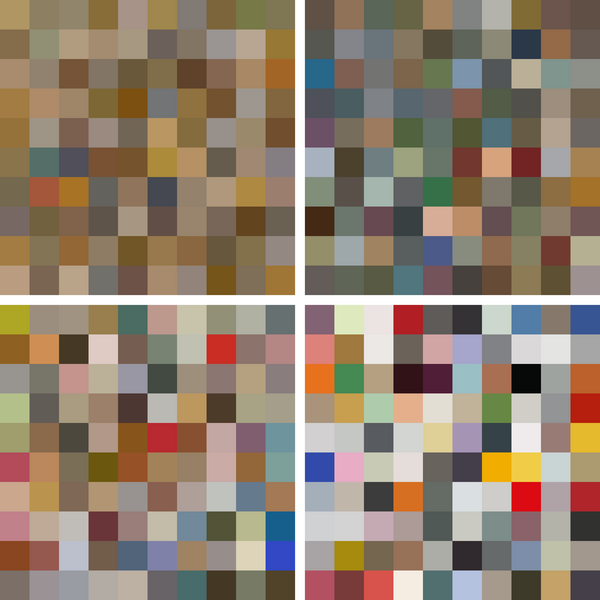 Byzantine, Surrealism, Pop, Minimalism
Byzantine, Surrealism, Pop, MinimalismLet's complicate the issue. How to highlight a large amount of work with any features that affect the result? The history itself suggests the principle of dividing artists by style. Let's compare Byzantine art, Renaissance, Baroque, Impressionism, Cubism, Fauvism, Conceptual art and other movements. The difference is clear and multifaceted. You can draw conclusions and analyze. 2020, 30x30 inches each, archival pigment print on Exhibition fiber.
-
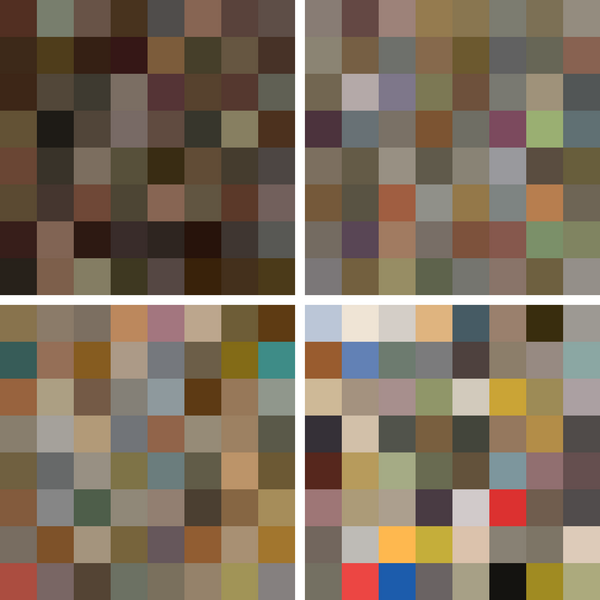 Baroque, Cubism, Dada, Conceptualism
Baroque, Cubism, Dada, ConceptualismLet's complicate the issue. How to highlight a large amount of work with any features that affect the result? The history itself suggests the principle of dividing artists by style. Let's compare Byzantine art, Renaissance, Baroque, Impressionism, Cubism, Fauvism, Conceptual art and other movements. The difference is clear and multifaceted. You can draw conclusions and analyze. 2020, 30x30 inches each, archival pigment print on Exhibition fiber.
-
 1913,1919 and 1938,1946
1913,1919 and 1938,1946How do wars affect art? Is there something in color that betrays a premonition of war and something that indicates war-weariness at the end of it? For the experiment, I used the years preceding and following the two great wars of the twentieth century: 1913, 1919 and 1938, 1946. Intuition suggested that the difference would be obvious, but the result surprised me. Perhaps the artists of the twentieth century did not reflect on real life as much as belonging to any art movement. 2022, 30x30 inches each, archival pigment print on Exhibition fiber.
-
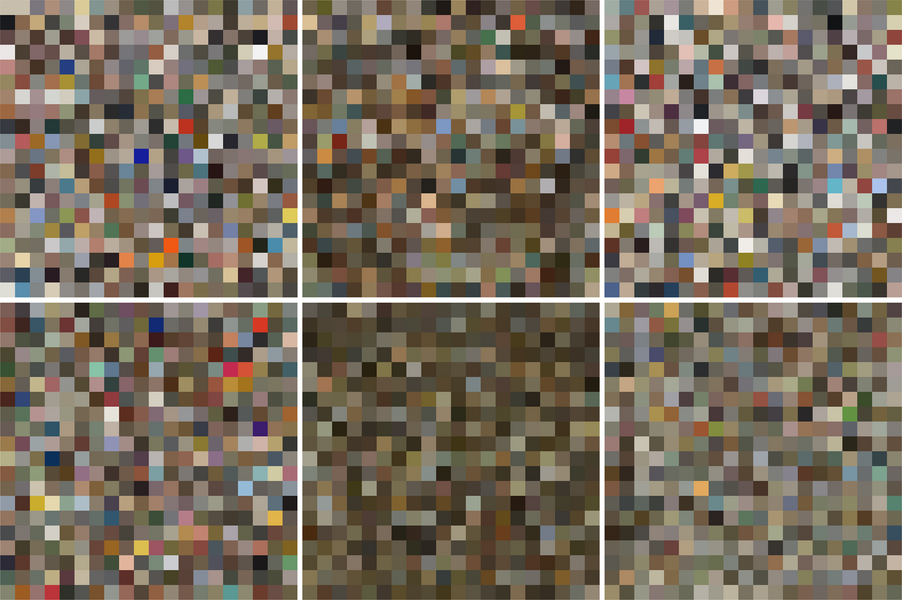 Guggenheim, Metropolitan, MoMA, Pompidou, Louvre, d'Orsay
Guggenheim, Metropolitan, MoMA, Pompidou, Louvre, d'OrsayMuseums. Do long-term collections, biases of different selection committees and curators affect the color of pixel compositions? For even greater “beauty” of the experiment, I choose 3 museums in New York (Metropolitan, Guggenheim, MOMA) and 3 museums in Paris (Louvre, d’Orsay, Center J. Pompidou). There is a difference. Not so striking. But it gives food for thought. 2022, 30x30 inches each, archival pigment print on Exhibition fiber.
-
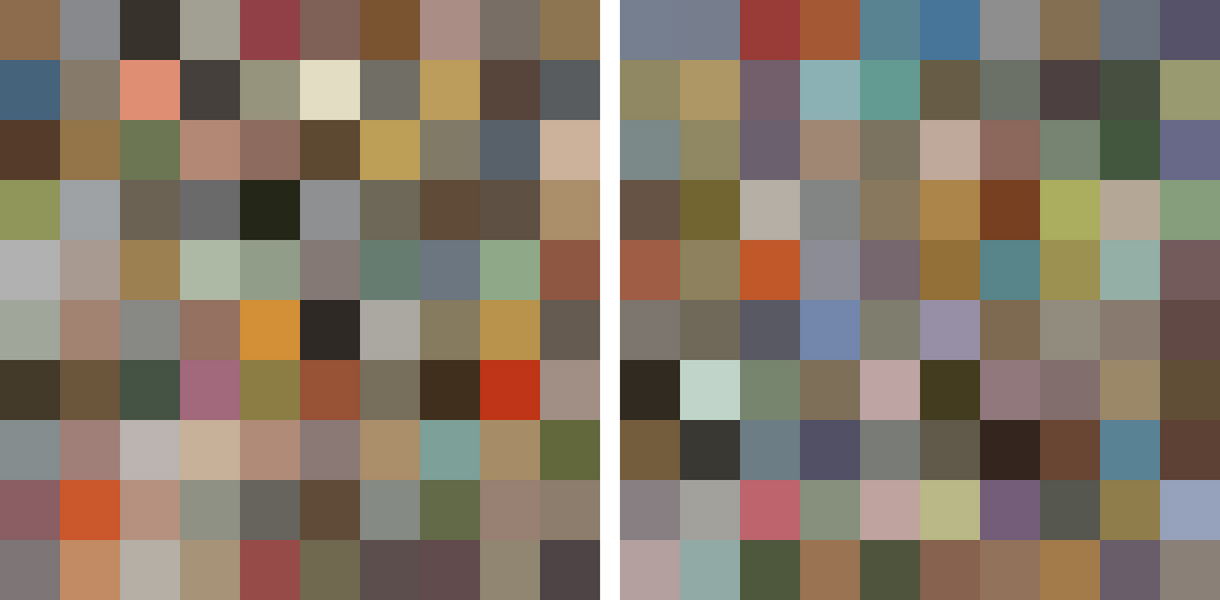 Most Expensive and Bad Paintings
Most Expensive and Bad PaintingsWorking on comparing the most expensive paintings (between $75 and almost $500 millions) and the bad paintings (official movement) in my project, I realized that the history of painting is a billion shades of gray. 2022, 30x30 inches each, archival pigment print on Exhibition fiber.
-
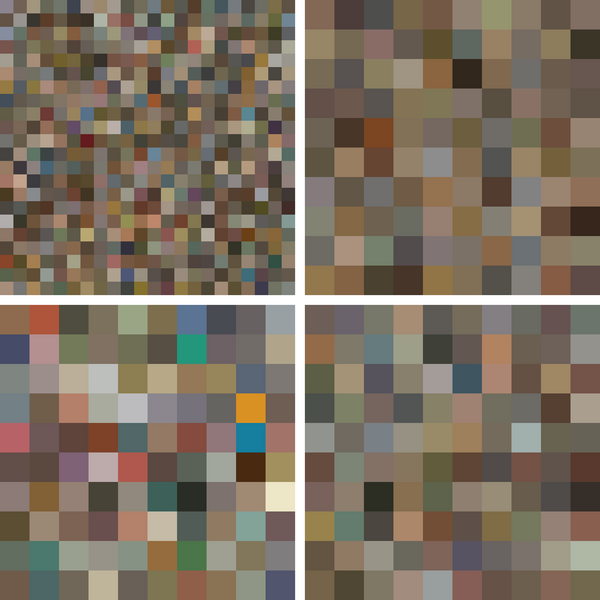 Degenerate, Nazi, Nonconformism, Soviet
Degenerate, Nazi, Nonconformism, SovietHow do political leanings affect art? Politicians classify artists as one group or another. We remember the "degenerate art" during the third Reich and can compare it with the official creations (small but manageable difficulty in finding work) of the same period. A couple of Soviet and nonconformist arts in the USSR is also interesting. Influence and very eloquently. 2022, 30x30 inches each, archival pigment print on Exhibition fiber.
-
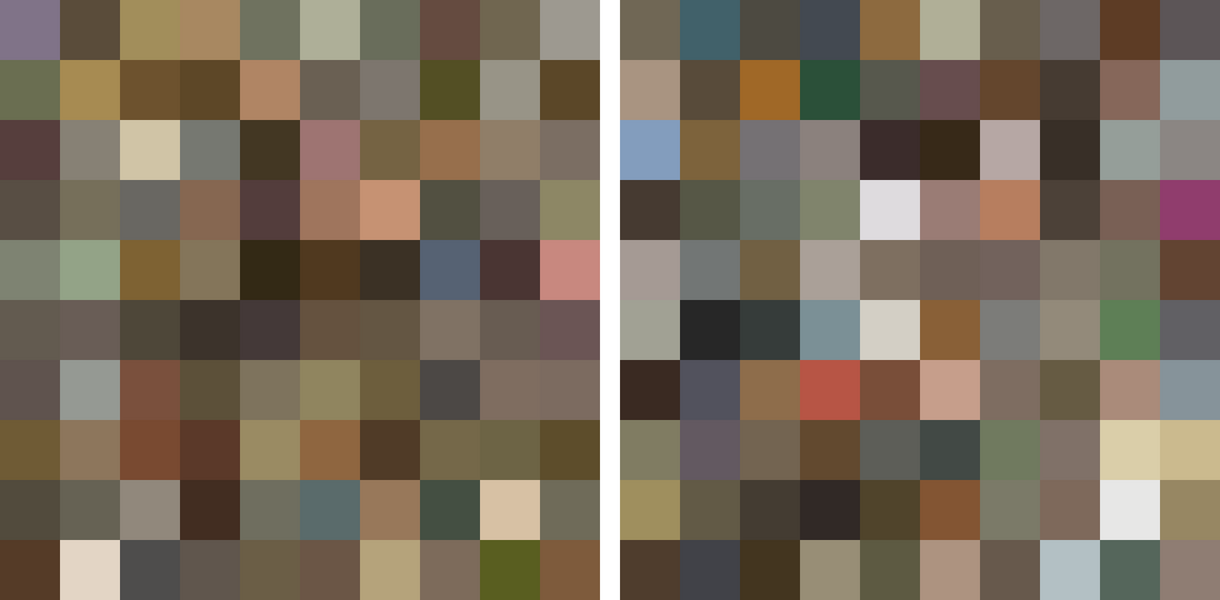 Art of Youth and Wisdom
Art of Youth and WisdomWe know many examples of the creative longevity of artists. Let's see how youthful enthusiasm is replaced by skill and wisdom. Each of the 100 artists is represented by one of their first and last works. 2022, 30x30 inches each, archival pigment print on Exhibition fiber.
-
 Stained Glass and Mosaic
Stained Glass and MosaicSpeaking about the influence on color in the history of art, one cannot avoid such an important topic as the material used by artists. In addition to tempera, oil paints, acrylic, we should pay attention to stained glass and mosaics. For an adequate result, I use the works of the classical period for these materials. Also, when working on stained glass windows, I remove the color of lead from the averaging, which almost always looks like black on photographs. 2022, 30x30 inches each, archival pigment print on Exhibition fiber.
-
 Art of Nations
Art of NationsIt is not about finding differences, but about identifying commonality of the color pixel, despite ... the differences of nations. In this case, it is necessary to comply a single algorithm for selecting pictures and their color averaging. The first is a selection of 100 countries with a sufficient number of artists in Google search. Second - each country is represented by 35-50 authors, one (the first in the search display) picture from each artist. Third - step by step averaging of each work, transforming into a same size pixel and averaging all 35-50 pixels into one, then placing them in alphabetical order. 100 (10x10) pixel-nations with fairly similar hues. Does this mean that there are national differences in general color? No, a more complete sample is needed for such verification. Perhaps we need all artists of every country and all of their works. Also this result will depend on the changes in color reproduction when working in Photoshop by millions of photographers and a displacement of this mass of photos across the expanses of Google. 2022, 30x30 inches, archival pigment print on Exhibition fiber.
Numbers and Letters
I was struck by the precision of the contours of numbers and letters, along with the expression of the brushstroke. I saw the artist’s goal as maintaining the level of abstraction while respecting in painting freedom.
I got an idea to apply a deeper level of abstraction using my own artistic language. Abandoning the texture, I focused more on color combinations and strict geometric shapes with recognizable numbers and letters.
Later, I expanded the project by adding artists who used lettering in their practice. These included: Albers, Boetti, Cy Twombly, Indiana, Mel Bochner and Paul Klee.
-
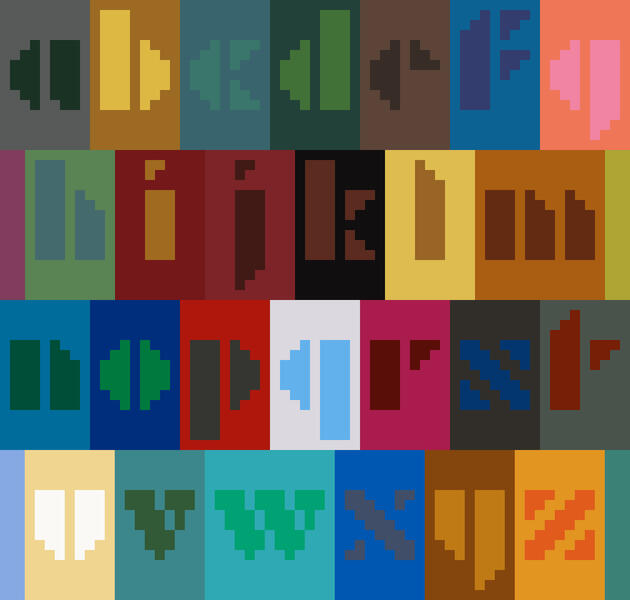 Alphabet after AlbersAlphabet after Albers, from Numbers and Letters Project, 2022. All colors was taken from original Albers work.
Alphabet after AlbersAlphabet after Albers, from Numbers and Letters Project, 2022. All colors was taken from original Albers work. -
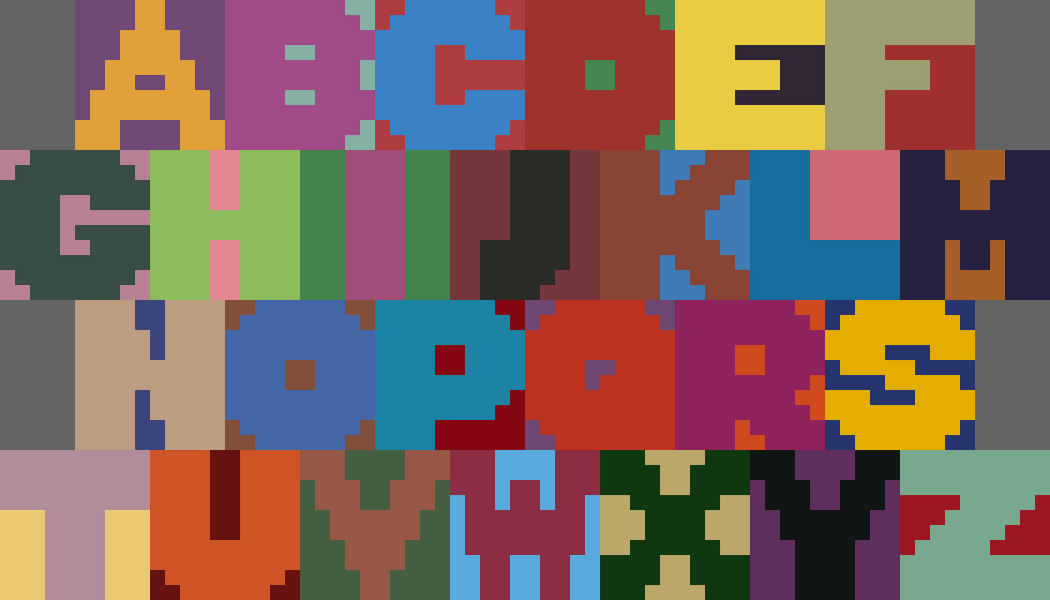 Alphabet after BoettiAlphabet after Boetti, from Numbers and Letters Project, 2022. All colors was taken from Boetti work.
Alphabet after BoettiAlphabet after Boetti, from Numbers and Letters Project, 2022. All colors was taken from Boetti work. -
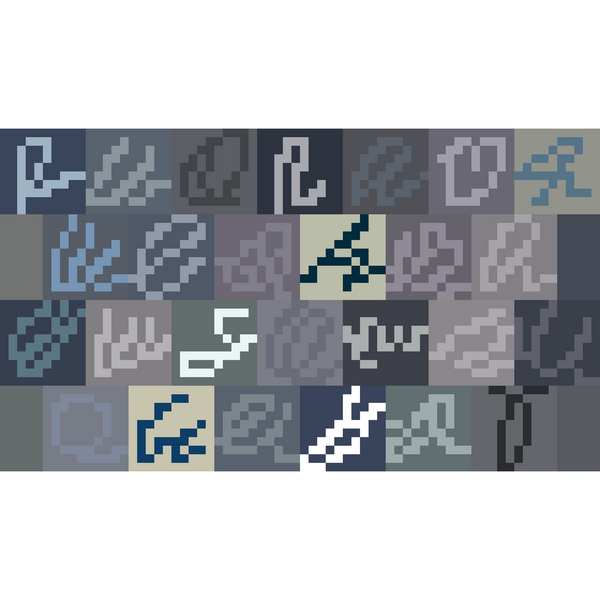 Alphabet after Cy TwomblyAlphabet after Cy Twombly, from Numbers and Letters Project, 2022. All colors was taken from Cy Twombly work.
Alphabet after Cy TwomblyAlphabet after Cy Twombly, from Numbers and Letters Project, 2022. All colors was taken from Cy Twombly work. -
 Alphabet after IndianaAlphabet after Indiana, from Numbers and Letters Project, 2022. All colors was taken from Indiana work.
Alphabet after IndianaAlphabet after Indiana, from Numbers and Letters Project, 2022. All colors was taken from Indiana work. -
 0-9After Jasper Johns numbers, from Numbers and Letters Project, 2022
0-9After Jasper Johns numbers, from Numbers and Letters Project, 2022 -
 SudokuSudoku, from Numbers and Letters Project, 2022, made with numbers after Jasper Johns.
SudokuSudoku, from Numbers and Letters Project, 2022, made with numbers after Jasper Johns.
Periodic Table of Art Elements: Conceptualism, 2021
that ubiquitous history from a universal point-of-view.
-
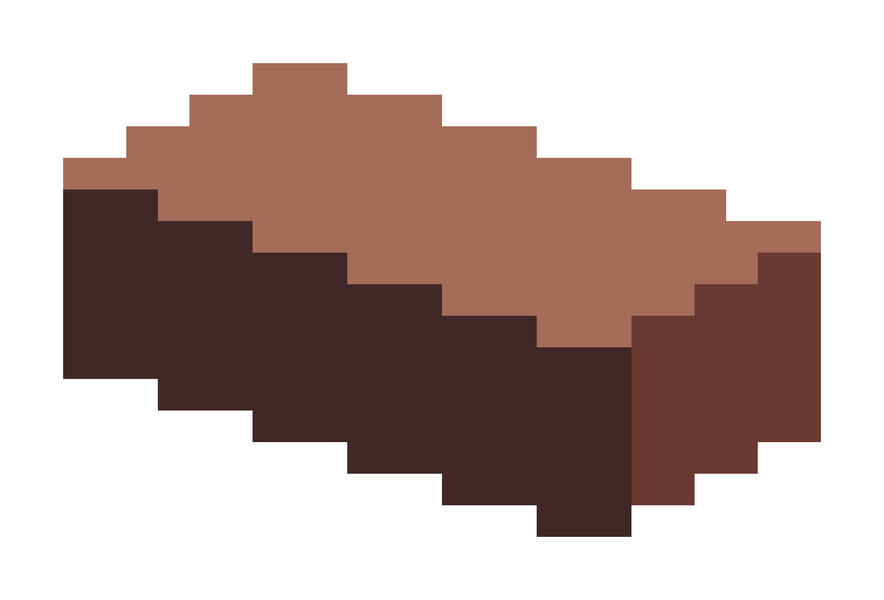 Joseph BeuysJoseph Beuys was a German artist, teacher, and theorist of art who was highly influential in international contemporary art in the latter half of the 20th century. He is a founder of the art movement known as Fluxus, and a practitioner and exemplar of happenings, and performance art.
Joseph BeuysJoseph Beuys was a German artist, teacher, and theorist of art who was highly influential in international contemporary art in the latter half of the 20th century. He is a founder of the art movement known as Fluxus, and a practitioner and exemplar of happenings, and performance art. -
 Bernhard and Hilla BecherBernhard "Bernd" Becher, and Hilla Becher, were German conceptual artists and photographers working as a collaborative duo. They are best known for their extensive series of photographic images, or typologies, of industrial buildings and structures, often organised in grids.
Bernhard and Hilla BecherBernhard "Bernd" Becher, and Hilla Becher, were German conceptual artists and photographers working as a collaborative duo. They are best known for their extensive series of photographic images, or typologies, of industrial buildings and structures, often organised in grids. -
 Barbara KrugerBarbara Kruger addresses media and politics in their native tongue: sensational, authoritative, and direct. Personal pronouns like “you” and “I” are staples of Kruger’s practice, bringing the viewer into each piece. “Direct address has motored my work from the very beginning,” Kruger said.” She demands that we consider how our identities are formed within culture, through representation in language and image.
Barbara KrugerBarbara Kruger addresses media and politics in their native tongue: sensational, authoritative, and direct. Personal pronouns like “you” and “I” are staples of Kruger’s practice, bringing the viewer into each piece. “Direct address has motored my work from the very beginning,” Kruger said.” She demands that we consider how our identities are formed within culture, through representation in language and image. -
 Chris BurdenChris Burden has produced some of the most shocking works in the history of 20th century American art, including spending five days and nights in the fetal position inside a locker, having a spectator push pins into his body, being "crucified" to a Volkswagen Beetle, being kicked down two flights of stairs, and even having himself shot. The challenge for viewers is to try to understand such troubling and seemingly "inartistic" gestures. Such an understanding is made possible by seeing these works within the context of Conceptual art during the 1970s, where artists concerned themselves with art based on ideas and action rather than objects created for an elite art market.
Chris BurdenChris Burden has produced some of the most shocking works in the history of 20th century American art, including spending five days and nights in the fetal position inside a locker, having a spectator push pins into his body, being "crucified" to a Volkswagen Beetle, being kicked down two flights of stairs, and even having himself shot. The challenge for viewers is to try to understand such troubling and seemingly "inartistic" gestures. Such an understanding is made possible by seeing these works within the context of Conceptual art during the 1970s, where artists concerned themselves with art based on ideas and action rather than objects created for an elite art market. -
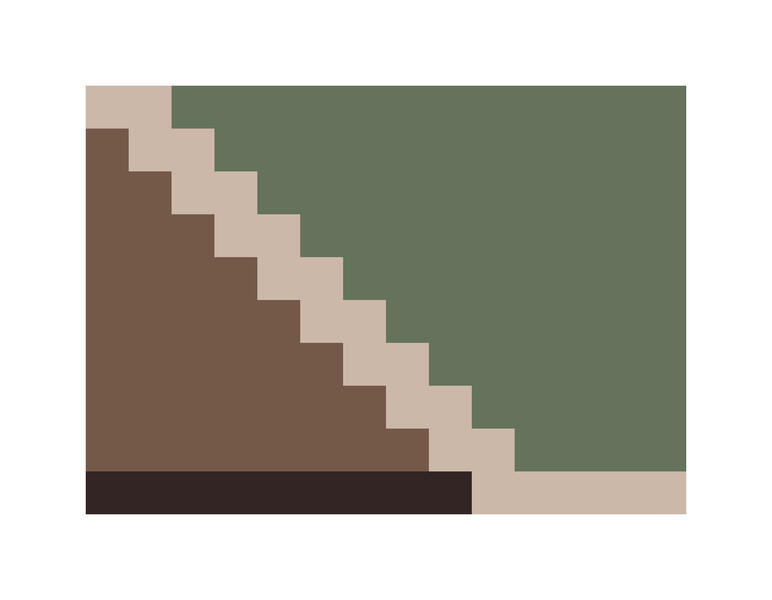 Gordon Matta-ClarkMatta-Clark’s iconic deconstruction practice of directly hacking into hard walls was a sophisticated negotiation of physical boundaries that insisted on the primacy of physical force tied to the artistic imagination.
Gordon Matta-ClarkMatta-Clark’s iconic deconstruction practice of directly hacking into hard walls was a sophisticated negotiation of physical boundaries that insisted on the primacy of physical force tied to the artistic imagination. -
 Erwin WurmErwin Wurm is a contemporary Austrian artist working across several media. Wurm’s comical attitude towards representation features heavily in his Fat Car series, in which he purposefully disfigures car models deemed status symbols by mass culture. Following in the tradition of Joseph Beuys, the artist has contributed his own take on the medium of sculpture with his One Minute Sculptures. In these performances, Wurm invites audience participation and interaction to reevaluate the medium.
Erwin WurmErwin Wurm is a contemporary Austrian artist working across several media. Wurm’s comical attitude towards representation features heavily in his Fat Car series, in which he purposefully disfigures car models deemed status symbols by mass culture. Following in the tradition of Joseph Beuys, the artist has contributed his own take on the medium of sculpture with his One Minute Sculptures. In these performances, Wurm invites audience participation and interaction to reevaluate the medium. -
 Damien HirstDamien Hirst is a British Conceptual artist known for his controversial take on beauty and found-art objects. Death is a central theme in Hirst's works. He became famous for a series of artworks in which dead animals (including a shark, a sheep and a cow) are preserved, sometimes having been dissected, in formaldehyde. The best-known of these was The Physical Impossibility of Death in the Mind of Someone Living, a 14-foot (4.3 m) tiger shark immersed in formaldehyde in a clear display case.
Damien HirstDamien Hirst is a British Conceptual artist known for his controversial take on beauty and found-art objects. Death is a central theme in Hirst's works. He became famous for a series of artworks in which dead animals (including a shark, a sheep and a cow) are preserved, sometimes having been dissected, in formaldehyde. The best-known of these was The Physical Impossibility of Death in the Mind of Someone Living, a 14-foot (4.3 m) tiger shark immersed in formaldehyde in a clear display case. -
 On KawaraOn Kawara was an influential Japanese Conceptual artist. Best known for his Today series of paintings, Kawara produced simple, two-color acrylic paintings to document each day he woke up alive in the date, language, and format of the place in which they were made.
On KawaraOn Kawara was an influential Japanese Conceptual artist. Best known for his Today series of paintings, Kawara produced simple, two-color acrylic paintings to document each day he woke up alive in the date, language, and format of the place in which they were made. -
 John BaldessariJohn Baldessari was an American Conceptual artist known for his pioneering use of appropriated imagery. By blending photography, painting, and text, Baldessari’s work examines the plastic nature of artistic media while offering commentary on our contemporary culture.
John BaldessariJohn Baldessari was an American Conceptual artist known for his pioneering use of appropriated imagery. By blending photography, painting, and text, Baldessari’s work examines the plastic nature of artistic media while offering commentary on our contemporary culture. -
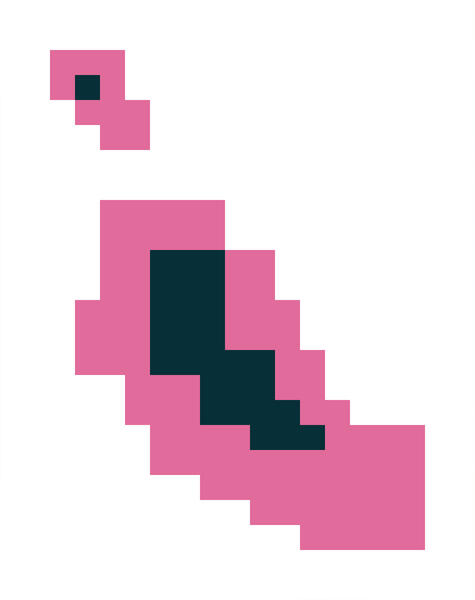 ChristoChristo, is a conceptual artist who turned to epic-scale environmental works in the late 1960s. His work was typically large, visually impressive, and controversial, often taking years and sometimes decades of careful preparation – including technical solutions, political negotiation, permitting and environmental approval, hearings and public persuasion.
ChristoChristo, is a conceptual artist who turned to epic-scale environmental works in the late 1960s. His work was typically large, visually impressive, and controversial, often taking years and sometimes decades of careful preparation – including technical solutions, political negotiation, permitting and environmental approval, hearings and public persuasion.
The Periodic Table of Art Elements, 2021-2024
Having spent countless hours in my studio and not venturing out much during to the pandemic, I had the time to look toward art history and visual culture as reference points in developing a new project. Titled “The Periodic Table of Art Elements,” my intention was to breakdown and reconstruct an imagining of its various eras, trends, styles and individual artist works as neural networks, the manner by which information is decoded, interconnected, and made interdependent. My goal here was to identify and then fuse the random and disparate visual languages I discovered throughout art history and then remake them in my own visual, pixelated vocabulary. Much like the famed periodic table of chemical elements, my project, using a scientific approach, creates a logical display and expressive presentation of art history’s most iconic works. The result of which, is both alien and familiar as it engages audiences to see that ubiquitous history from a universal point-of-view.
-
 The Periodic Table of Art Elements
The Periodic Table of Art ElementsHaving spent countless hours in my studio and not venturing out much during to the pandemic, I had the time to look toward art history and visual culture as reference points in developing a new project. Titled “The Periodic Table of Art Elements,” my intention was to breakdown and reconstruct an imagining of its various eras, trends, styles and individual artist works as neural networks, the manner by which information is decoded, interconnected, and made interdependent. My goal here was to identify and then fuse the random and disparate visual languages I discovered throughout art history and then remake them in my own visual, pixelated vocabulary. Much like the famed periodic table of chemical elements, my project, using a scientific approach, creates a logical display and expressive presentation of art history’s most iconic works. The result of which, is both alien and familiar as it engages audiences to see that ubiquitous history from a universal point-of-view.
Available for Purchase -
 AbramovicAvailable for Purchase
AbramovicAvailable for Purchase -
 VermeerAvailable for Purchase
VermeerAvailable for Purchase -
 BasquiatAvailable for Purchase
BasquiatAvailable for Purchase -
 SuhAvailable for Purchase
SuhAvailable for Purchase -
 GoyaAvailable for Purchase
GoyaAvailable for Purchase -
 Chuck CloseAvailable for Purchase
Chuck CloseAvailable for Purchase -
 PollockAvailable for Purchase
PollockAvailable for Purchase -
 HokusaiAvailable for Purchase
HokusaiAvailable for Purchase -
 BecherAvailable for Purchase
BecherAvailable for Purchase
Periodic Table of Art Elements: Pop Art, 2021
that ubiquitous history from a universal point-of-view.
-
 Roy LichtensteinRoy Lichtenstein was an American pop artist. During the 1960s, along with Andy Warhol, Jasper Johns, and James Rosenquist among others, he became a leading figure in the new art movement. His work defined the premise of pop art through parody. Inspired by the comic strip, Lichtenstein produced precise compositions that documented while they parodied, often in a tongue-in-cheek manner.
Roy LichtensteinRoy Lichtenstein was an American pop artist. During the 1960s, along with Andy Warhol, Jasper Johns, and James Rosenquist among others, he became a leading figure in the new art movement. His work defined the premise of pop art through parody. Inspired by the comic strip, Lichtenstein produced precise compositions that documented while they parodied, often in a tongue-in-cheek manner. -
 Peter BlakePeter Blake is often called the "Godfather of British Pop art." Like many artists of his time, he came of age in a country recovering from the war, so much of his interests were drawn toward the bright and happy lifestyle that was being touted in America via a booming advertising industry utilizing groundbreaking new methods such as screen-printing to create optimistic and bold renditions of life in magazines, on posters, and on billboards.
Peter BlakePeter Blake is often called the "Godfather of British Pop art." Like many artists of his time, he came of age in a country recovering from the war, so much of his interests were drawn toward the bright and happy lifestyle that was being touted in America via a booming advertising industry utilizing groundbreaking new methods such as screen-printing to create optimistic and bold renditions of life in magazines, on posters, and on billboards. -
 Dan FlavinDan Flavin was an American artist and pioneer of Minimalism, best known for his seminal installations of light fixtures. His illuminated sculptures offer a rigorous formal and conceptual investigation of space and light, wherein the artist arranged commercial fluorescent bulbs into differing geometric compositions.
Dan FlavinDan Flavin was an American artist and pioneer of Minimalism, best known for his seminal installations of light fixtures. His illuminated sculptures offer a rigorous formal and conceptual investigation of space and light, wherein the artist arranged commercial fluorescent bulbs into differing geometric compositions. -
 Duane HansonDuane Hanson is best known for his hyperrealistic, life-size sculptures of everyday Americans. His subjects have included repairmen, waitresses, dead soldiers, the homeless, and—perhaps most famously—the stereotypical Middle American tourist. Hanson adopts a Pop art approach to representing the mundane and embraces photorealism’s commitment to veracity; his unsettling works blur the lines between art and life.
Duane HansonDuane Hanson is best known for his hyperrealistic, life-size sculptures of everyday Americans. His subjects have included repairmen, waitresses, dead soldiers, the homeless, and—perhaps most famously—the stereotypical Middle American tourist. Hanson adopts a Pop art approach to representing the mundane and embraces photorealism’s commitment to veracity; his unsettling works blur the lines between art and life. -
 David HockneyDavid Hockney is an English painter, draftsman, printmaker, photographer, and stage designer whose works were characterized by economy of technique, a preoccupation with light, and a frank mundane realism derived from Pop art and photography.
David HockneyDavid Hockney is an English painter, draftsman, printmaker, photographer, and stage designer whose works were characterized by economy of technique, a preoccupation with light, and a frank mundane realism derived from Pop art and photography. -
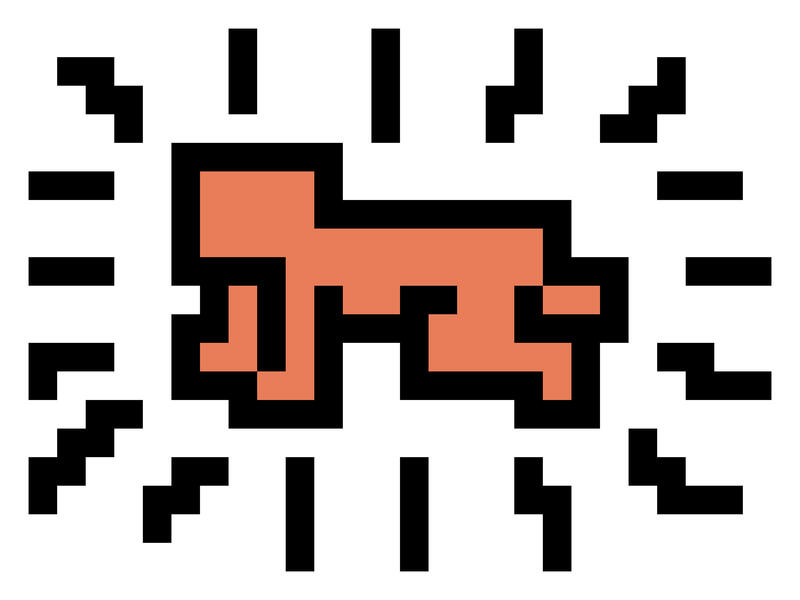 Keith HaringKeith Haring was an American artist whose pop art emerged from the New York City graffiti subculture of the 1980s. His animated imagery has "become a widely recognized visual language". Much of his work includes sexual allusions that turned into social activism by using the images to advocate for safe sex and AIDS awareness.
Keith HaringKeith Haring was an American artist whose pop art emerged from the New York City graffiti subculture of the 1980s. His animated imagery has "become a widely recognized visual language". Much of his work includes sexual allusions that turned into social activism by using the images to advocate for safe sex and AIDS awareness. -
 Jasper JohnsJasper Johns is an American painter, sculptor, and printmaker whose work is associated with abstract expressionism, Neo-Dada, and pop art. He is well known for his depictions of the American flag and other US-related topics.
Jasper JohnsJasper Johns is an American painter, sculptor, and printmaker whose work is associated with abstract expressionism, Neo-Dada, and pop art. He is well known for his depictions of the American flag and other US-related topics. -
 Alexander CalderAlexander Calder changed the course of modern art with his three-dimensional kinetic sculptures, which Marcel Duchamp named “mobiles.” Resonating with tenets of Futurism, Constructivism, and early non-objective painting, Calder’s mobiles consist of boldly colored abstract shapes, which are made from industrial materials and hang in lyrical balance.
Alexander CalderAlexander Calder changed the course of modern art with his three-dimensional kinetic sculptures, which Marcel Duchamp named “mobiles.” Resonating with tenets of Futurism, Constructivism, and early non-objective painting, Calder’s mobiles consist of boldly colored abstract shapes, which are made from industrial materials and hang in lyrical balance. -
 Ed RuschaEd Ruscha's use of the imagery and techniques seen in commercial art such as advertising and his interest in popular culture and the everyday, connects him directly with pop art. He was also very influential to the development of conceptual art through his depiction of words and phrases, and his books of deadpan photographs characterised by their low-key humour.
Ed RuschaEd Ruscha's use of the imagery and techniques seen in commercial art such as advertising and his interest in popular culture and the everyday, connects him directly with pop art. He was also very influential to the development of conceptual art through his depiction of words and phrases, and his books of deadpan photographs characterised by their low-key humour. -
 Tom WesselmannTom Wesselmann was one of the leading American Pop artists of the 1960s. Departing from Abstract Expressionism, he explored classical representations of the nude, still life, and landscape, while incorporating everyday objects and advertising ephemera.
Tom WesselmannTom Wesselmann was one of the leading American Pop artists of the 1960s. Departing from Abstract Expressionism, he explored classical representations of the nude, still life, and landscape, while incorporating everyday objects and advertising ephemera.
Periodic Table of Art Elements: Prehistoric and Ancient Art, 2021
-
 AboriginalThe use of symbols is an alternate way to writing down stories of cultural significance, teaching survival and use of the land.
AboriginalThe use of symbols is an alternate way to writing down stories of cultural significance, teaching survival and use of the land. -
 AnubisAnubis, ancient Egyptian god of the dead, represented by a jackal or the figure of a man with the head of a jackal. In the Early Dynastic period and the Old Kingdom, he enjoyed a preeminent (though not exclusive) position as lord of the dead, but he was later overshadowed by Osiris.
AnubisAnubis, ancient Egyptian god of the dead, represented by a jackal or the figure of a man with the head of a jackal. In the Early Dynastic period and the Old Kingdom, he enjoyed a preeminent (though not exclusive) position as lord of the dead, but he was later overshadowed by Osiris. -
 AztecAztec art is known to have shown realistic expression of characteristics such as age and expression.
AztecAztec art is known to have shown realistic expression of characteristics such as age and expression. -
 CentaursCentaurs were a tribe of half-man, half-horse savages who inhabited the mountains and forests of Thessalian Magnesia.
CentaursCentaurs were a tribe of half-man, half-horse savages who inhabited the mountains and forests of Thessalian Magnesia. -
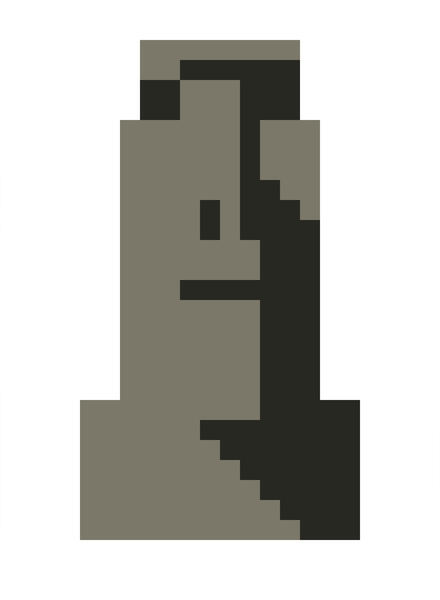 MoaiMoai statues were built to honor chieftain or other important people who had passed away. The moais were intentionally made with different characteristics since they were intended to keep the appearence of the person it represented.
MoaiMoai statues were built to honor chieftain or other important people who had passed away. The moais were intentionally made with different characteristics since they were intended to keep the appearence of the person it represented. -
 Nazca LinesThe Nazca Lines are a collection of giant geoglyphs—designs or motifs etched into the ground—located in Peru. The Nazca Lines are perhaps best known for the representations of about 70 animals and plants, some of which measure up to 1,200 feet (370 meters) long.
Nazca LinesThe Nazca Lines are a collection of giant geoglyphs—designs or motifs etched into the ground—located in Peru. The Nazca Lines are perhaps best known for the representations of about 70 animals and plants, some of which measure up to 1,200 feet (370 meters) long. -
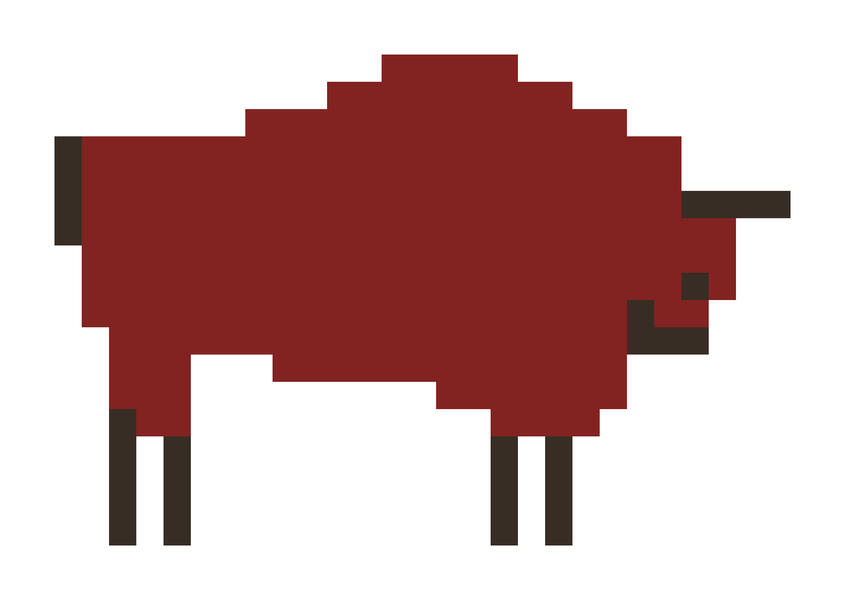 PaleolithicPaleolithic art concerned itself with either food (hunting scenes, animal carvings) or fertility (Venus figurines). Its predominant theme was animals. It is considered to be an attempt, by Stone Age peoples, to gain some sort of control over their environment, whether by magic or ritual.
PaleolithicPaleolithic art concerned itself with either food (hunting scenes, animal carvings) or fertility (Venus figurines). Its predominant theme was animals. It is considered to be an attempt, by Stone Age peoples, to gain some sort of control over their environment, whether by magic or ritual. -
 Romulus Remus (Capitoline) WolfThe image of the she-wolf suckling Romulus and Remus is a symbol of Rome since ancient times, and one of the most recognizable icons of ancient mythology.
Romulus Remus (Capitoline) WolfThe image of the she-wolf suckling Romulus and Remus is a symbol of Rome since ancient times, and one of the most recognizable icons of ancient mythology. -
 SphinxA sphinx is a creature with the body of a lion and the head of a human, with some variations. It is a prominent mythological figure in Egyptian, Asian, and Greek mythology.
SphinxA sphinx is a creature with the body of a lion and the head of a human, with some variations. It is a prominent mythological figure in Egyptian, Asian, and Greek mythology. -
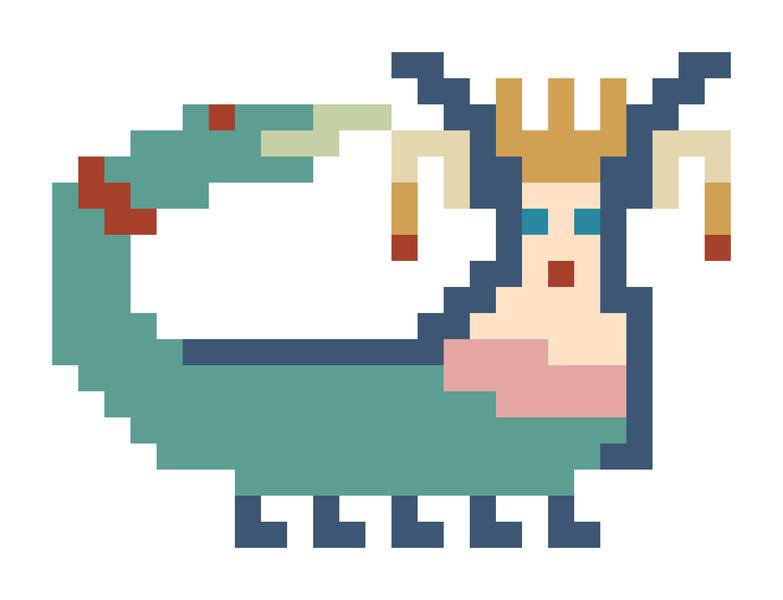 Shahmaran“Shahmaran,” meaning “Shah (King) of the Snakes” in Persian, is a mythical creature, half woman and half snake. This creature, which is mostly seen in mural paintings and believed to be the ruler of the snakes, guards treasures and kills with its breath and gaze.
Shahmaran“Shahmaran,” meaning “Shah (King) of the Snakes” in Persian, is a mythical creature, half woman and half snake. This creature, which is mostly seen in mural paintings and believed to be the ruler of the snakes, guards treasures and kills with its breath and gaze.
Periodic Table of Art Elements: Early XX century, 2021
-
 Pablo PicassoPablo Picasso, painter, sculptor, etcher, lithographer, ceramist and designer, who has had enormous influence on 20th century art and worked in an unprecedented variety of styles. Picasso may be best known for pioneering Cubism and fracturing the two-dimensional picture plane in order to convey three-dimensional space. Inspired by African and Iberian art, he also contributed to the rise of Surrealism and Expressionism.
Pablo PicassoPablo Picasso, painter, sculptor, etcher, lithographer, ceramist and designer, who has had enormous influence on 20th century art and worked in an unprecedented variety of styles. Picasso may be best known for pioneering Cubism and fracturing the two-dimensional picture plane in order to convey three-dimensional space. Inspired by African and Iberian art, he also contributed to the rise of Surrealism and Expressionism. -
 Henri MatisseThroughout his decades-long career as a painter, sculptor, draftsman, and printmaker, Henri Matisse continuously searched, in his own words, “for the same things, which I have perhaps realized by different means.” Celebrated as both an orchestrator of tonal harmonies and a draftsman capable of distilling a form to its essentials, he long sought a way to unite color and line in his work.
Henri MatisseThroughout his decades-long career as a painter, sculptor, draftsman, and printmaker, Henri Matisse continuously searched, in his own words, “for the same things, which I have perhaps realized by different means.” Celebrated as both an orchestrator of tonal harmonies and a draftsman capable of distilling a form to its essentials, he long sought a way to unite color and line in his work. -
 Hans ArpSomething of a one-man movement, Jean Arp could (and did) make anything into art. Best-known for his biomorphic sculptures, and one of the most versatile creative minds of the early-20th century. His approach to form, often referred to as organic abstraction, was remarkably consistent: his wavy lines suggested plants, body parts and other natural motifs, while remaining entirely abstract.
Hans ArpSomething of a one-man movement, Jean Arp could (and did) make anything into art. Best-known for his biomorphic sculptures, and one of the most versatile creative minds of the early-20th century. His approach to form, often referred to as organic abstraction, was remarkably consistent: his wavy lines suggested plants, body parts and other natural motifs, while remaining entirely abstract. -
 René MagritteRene Magritte described his paintings saying, "My painting is visible images which conceal nothing; they evoke mystery and, indeed, when one sees one of my pictures, one asks oneself this simple question, 'What does that mean?' It does not mean anything, because mystery means nothing, it is unknowable."
René MagritteRene Magritte described his paintings saying, "My painting is visible images which conceal nothing; they evoke mystery and, indeed, when one sees one of my pictures, one asks oneself this simple question, 'What does that mean?' It does not mean anything, because mystery means nothing, it is unknowable." -
 Marc ChagallBelorussian-born French painter, printmaker, and designer who composed his images based on emotional and poetic associations, rather than on rules of pictorial logic. Art critic Robert Hughes referred to Chagall as "the quintessential Jewish artist of the twentieth century".
Marc ChagallBelorussian-born French painter, printmaker, and designer who composed his images based on emotional and poetic associations, rather than on rules of pictorial logic. Art critic Robert Hughes referred to Chagall as "the quintessential Jewish artist of the twentieth century". -
 Salvador DalíAn author, artist and provocateur, Salvador Dalí was one of the most notable figures of the Surrealist movement. Dalí’s most important contribution to Surrealism was the paranoiac-critical method, a surrealist technique he developed in the 1930s.
Salvador DalíAn author, artist and provocateur, Salvador Dalí was one of the most notable figures of the Surrealist movement. Dalí’s most important contribution to Surrealism was the paranoiac-critical method, a surrealist technique he developed in the 1930s. -
 Kazimir MalevichKazimir Malevich, an artist as influential as he was radical, cast a long shadow over the history of modern art. His early experiments as a painter led him towards the invention of suprematism, a bold visual language of abstract geometric shapes and stark colours, epitomised by the Black Square.
Kazimir MalevichKazimir Malevich, an artist as influential as he was radical, cast a long shadow over the history of modern art. His early experiments as a painter led him towards the invention of suprematism, a bold visual language of abstract geometric shapes and stark colours, epitomised by the Black Square. -
 Man RayMan Ray was an American avant-garde artist and leading figure in the Dada and Surrealist movements. A pioneer in painting, film, and collage, Man Ray is best known for his black-and-white photographs. “My works were designed to amuse, annoy, bewilder, mystify and inspire reflection,” he once stated.
Man RayMan Ray was an American avant-garde artist and leading figure in the Dada and Surrealist movements. A pioneer in painting, film, and collage, Man Ray is best known for his black-and-white photographs. “My works were designed to amuse, annoy, bewilder, mystify and inspire reflection,” he once stated. -
 Amedeo ModiglianiAmedeo Modigliani, Italian painter and sculptor whose portraits and nudes—characterized by asymmetrical compositions, elongated figures, and a simple but monumental use of line—are among the most-important portraits of the 20th century.
Amedeo ModiglianiAmedeo Modigliani, Italian painter and sculptor whose portraits and nudes—characterized by asymmetrical compositions, elongated figures, and a simple but monumental use of line—are among the most-important portraits of the 20th century. -
 Piet MondrianDutch pioneer of abstract art, who developed abstract style which he called Neo-Plasticism, restricted to the three primary colours and to a grid of black vertical and horizontal lines on a white ground. Mondrian's art was highly utopian and was concerned with a search for universal values and aesthetics.
Piet MondrianDutch pioneer of abstract art, who developed abstract style which he called Neo-Plasticism, restricted to the three primary colours and to a grid of black vertical and horizontal lines on a white ground. Mondrian's art was highly utopian and was concerned with a search for universal values and aesthetics.
Periodic Table of Art Elements: Contemporary Art, 2021
Having spent countless hours in my studio and not venturing out much during to the pandemic, I had the time to look toward art history and visual culture as reference points in developing a new project. Titled “The Periodic Table of Art Elements,” my intention was to breakdown and reconstruct an imagining of its various eras, trends, styles and individual artist works as neural networks, the manner by which information is decoded, interconnected, and made interdependent. My goal here was to identify and then fuse the random and disparate visual languages I discovered throughout art history and then remake them in my own visual, pixelated vocabulary. Much like the famed periodic table of chemical elements, my project, using a scientific approach, creates a logical display and expressive presentation of art history’s most iconic works. The result of which, is both alien and familiar as it engages audiences to see
that ubiquitous history from a universal point-of-view.
-
 Do Ho SuhDo Ho Suh is a Korean artist who works primarily in sculpture, installation, and drawing. Suh is well known for re-creating architectural structures and objects using fabric in what the artist describes as an "act of memorialization."
Do Ho SuhDo Ho Suh is a Korean artist who works primarily in sculpture, installation, and drawing. Suh is well known for re-creating architectural structures and objects using fabric in what the artist describes as an "act of memorialization." -
 Maurizio CattelanMaurizio Cattelan has been internationally recognized for his humorous and ironic works which provoke and challenge the limits of contemporary value systems. In choosing symbols whose representations offer complex systems of intertwined meaning.
Maurizio CattelanMaurizio Cattelan has been internationally recognized for his humorous and ironic works which provoke and challenge the limits of contemporary value systems. In choosing symbols whose representations offer complex systems of intertwined meaning. -
 Olafur EliassonOlafur Eliasson is an Icelandic–Danish artist known for sculptured and large-scale installation art employing elemental materials such as light, water, and air temperature to enhance the viewer’s experience.
Olafur EliassonOlafur Eliasson is an Icelandic–Danish artist known for sculptured and large-scale installation art employing elemental materials such as light, water, and air temperature to enhance the viewer’s experience. -
 John GerrardBreaching the divisions between portrait, landscape and history painting, generating moving images that no longer belong to ‘time-based media’, rethinking the monumentalism of land art in the age of Google Earth, and now exploring an expanded arena of choreography and performance, the innovative form of John Gerrard’s work keeps pace with the subtle complexity of its subject-matter.
John GerrardBreaching the divisions between portrait, landscape and history painting, generating moving images that no longer belong to ‘time-based media’, rethinking the monumentalism of land art in the age of Google Earth, and now exploring an expanded arena of choreography and performance, the innovative form of John Gerrard’s work keeps pace with the subtle complexity of its subject-matter. -
 GormleyAntony Gormley is widely acclaimed for his sculptures, installations and public artworks that investigate the relationship of the human body to space. Gormley continually tries to identify the space of art as a place of becoming in which new behaviours, thoughts and feelings can arise.
GormleyAntony Gormley is widely acclaimed for his sculptures, installations and public artworks that investigate the relationship of the human body to space. Gormley continually tries to identify the space of art as a place of becoming in which new behaviours, thoughts and feelings can arise. -
 Ann HamiltonAnn Hamilton is a contemporary American artist known for her multimedia installations which explore sensorial experience, history, and language. “Our culture has beheld with suspicion unproductive time, things not utilitarian, and daydreaming in general, but we live in a time when it is especially challenging to articulate the importance of experiences that don’t produce anything obvious, aren’t easily quantifiable, resist measurement, aren’t easily named, are categorically in-between,” she has said.
Ann HamiltonAnn Hamilton is a contemporary American artist known for her multimedia installations which explore sensorial experience, history, and language. “Our culture has beheld with suspicion unproductive time, things not utilitarian, and daydreaming in general, but we live in a time when it is especially challenging to articulate the importance of experiences that don’t produce anything obvious, aren’t easily quantifiable, resist measurement, aren’t easily named, are categorically in-between,” she has said. -
 Anish KapoorAnish Kapoor is known for elegant sculptures of spare geometries and organic forms, which he fabricates with feats of engineering. “That's what I am interested in: the void, the moment when it isn't a hole,” he explained. “It is a space full of what isn't there.”
Anish KapoorAnish Kapoor is known for elegant sculptures of spare geometries and organic forms, which he fabricates with feats of engineering. “That's what I am interested in: the void, the moment when it isn't a hole,” he explained. “It is a space full of what isn't there.” -
 Robert Longo“Art is an attempt to try and understand our own contemporary situation through making images that are completely personal, while also addressing our social context.” Longo works with characteristic scale, precision, and perceptiveness, achieving images that, while drawn from recent history, would be otherwise impossible to see with the human eye.
Robert Longo“Art is an attempt to try and understand our own contemporary situation through making images that are completely personal, while also addressing our social context.” Longo works with characteristic scale, precision, and perceptiveness, achieving images that, while drawn from recent history, would be otherwise impossible to see with the human eye. -
 Måns WrangeMåns Wrange is an artist based in Stockholm who works with long-term projects that explore the sophisticated methods and technologies that influence human behaviour, as used by financial market actors, national security agencies as well as the political lobbying and spin-doctor industry.
Måns WrangeMåns Wrange is an artist based in Stockholm who works with long-term projects that explore the sophisticated methods and technologies that influence human behaviour, as used by financial market actors, national security agencies as well as the political lobbying and spin-doctor industry. -
 Ron MueckRon Mueck's meticulously sculpted figures, ranging from the minute to the monumental, each reflect an inner world of private feelings with unsettling power. The startling realism of these works invites an empathetic engagement with the challenges and perils of our shared humanity.
Ron MueckRon Mueck's meticulously sculpted figures, ranging from the minute to the monumental, each reflect an inner world of private feelings with unsettling power. The startling realism of these works invites an empathetic engagement with the challenges and perils of our shared humanity.
